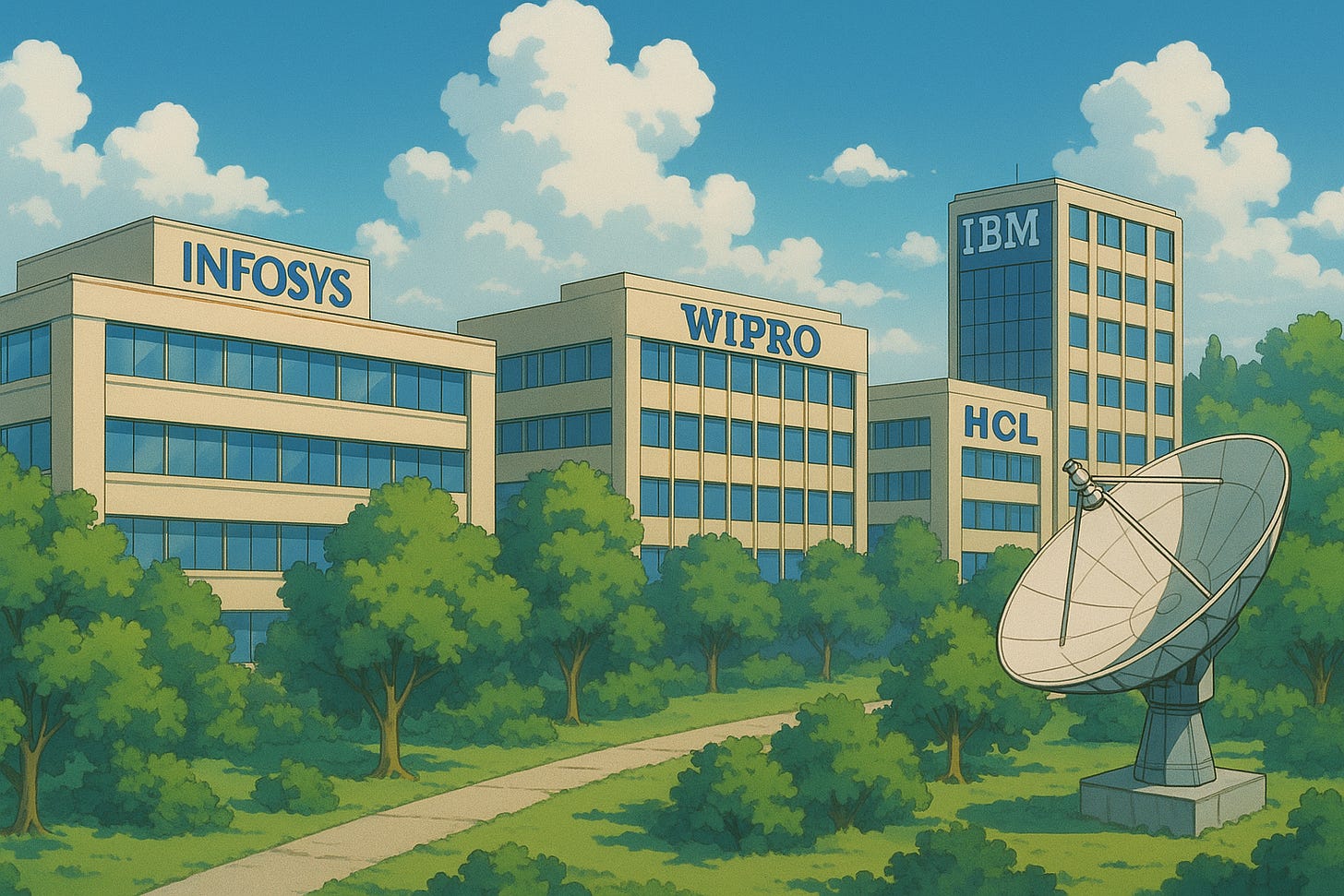How Bangalore Came To Be India's Tech Capital
A short story featuring satellites, dosa, and government acceptance of a 'dirty word'.
Hello and welcome back to Tigerfeathers!
A warm welcome to the 256 new subscribers who've joined since last week's piece about Mumbai's maverick hospitality group.
For everyone still making their way through the pair of essays we've published over the last two weeks (collectively longer than three out of seven Harry Potter books) - don't worry. We're not dropping another Ancient Epic-length reading assignment on you this time.
Instead, we’ve got a crisp little tale that answers a question that’s quietly irritated us Bombay-boys ever since we entered the tech world: how did Bangalore become India’s startup capital?
It’s a story full of policy quirks, historical oddities, and fermented rice pancake memes.
So let’s get into it. But first… a short word from our sponsors.
This edition of Tigerfeathers is presented in partnership with… Finarkein Analytics.
Finarkein Analytics, backed by Nexus Venture Partners, is a leading player in India's open finance and Digital Public Infrastructure ecosystem. They are trusted by some of the largest banks and NBFCs in India to power mission-critical workflows in lending, wealth, and insurance. If you want to unlock the power of India’s exciting new Account Aggregator framework, reach out to hello@finarkein.com to understand how they can help you transform your business using this revolution in financial infrastructure.
If you're interested in sponsoring a future edition of Tigerfeathers, get in touch with us on Twitter/LinkedIn or by replying to this email. With that, let’s get to it.
If you’ve been reading Tigerfeathers for any length of time, you may have noticed a recurring theme: many of the companies we cover are based in one city.
Whether it’s the fintech business pioneering the adoption of digital gold, the space tech company leading India’s private sector foray into the cosmos, or the consumer platform reimagining Hinduism for the smartphone age, the story is the same. All of these companies were either born in Bangalore, built in Bangalore, or quickly moved there to scale.
That’s no coincidence. Bangalore has become the gravitational centre of Indian tech. A place where venture capital, engineering talent, and startup energy have found a kind of critical mass.
But this is only the latest in a long line of avatars that the city has taken on. In the medieval era, Bangalore was a strategic southern outpost. It was ruled by the Hoysala dynasty, fortified by Kempegowda, and later transformed into a bastion of resistance under Tipu Sultan.
Over time, it evolved into a genteel, garden-filled cantonment under the British; a laid-back pensioners' paradise known more for its weather than its ambition.
And then, somehow, it became the startup capital of India.
Given that the technology sector is one of the largest and most strategic industries of all, how exactly did its Indian epicentre emerge from this sleepy, slow-moving city? Why not Delhi, the national seat of power, or Bombay, with its deep networks of capital, commerce, and cosmopolitanism?
Did you ever stop and think about that?
Not really, but surely this is the part where you tell us...
You’re damn right.
It’s a fascinating story; one that begins with an American semiconductor company and a satellite link. Let me explain.
In the 1980s, India’s economy was still tightly controlled by the government. Foreign investment was frowned upon, imports were heavily restricted, and starting any kind of business required a quasi-impossible government ‘license’.
Indeed, the very term ‘profit’ was considered “a dirty word” by Jawaharlal Nehru, India’s founding Prime Minister and the man whose socialist values shaped its post-Independence economy.
Unsurprisingly, there was no space for a serious Indian computing or software industry in this harsh climate.
However, in 1984, Prime Minister Rajiv Gandhi - Nehru’s own grandson - championed the New Computer Policy (NCP), a surprisingly bright piece of legislation in an otherwise bleak policy landscape.
The intent of this new regulation was to delicense computer manufacturing, reduce import duties on hardware, allow foreign investment into the sector, and ultimately encourage exports.
It was this policy that gave the initial tailwinds to firms like Wipro, Infosys, HCL, and TCS, who began assembling computers, writing code, and chasing global clients. But domestic companies weren’t the only ones to clamber through the window opened by the NCP.
A year after the policy was introduced, Texas Instruments (TI) became the first global technology giant to set up an R&D centre in India. For the uninitiated, TI is one of the largest semiconductor manufacturers in the world. Even today, they employ 34,000 people and make $5B of profit on a top line of $15B.

Back in 1985, the company was even more prestigious than it is today. They were one of the five largest global semiconductor firms and they made everything from analog chips for radios to integrated circuits for computers, phones, planes, and cars.
Their decision to set up an R&D center in India was enormously significant for the country, but for TI, it was also entirely logical. While semiconductor manufacturing was increasingly automated, the design and development of new chips still depended heavily on skilled human capital.
What TI needed was a deep bench of English-speaking engineers who could test and iterate on new chipset designs quickly and cost-effectively. And India, by sheer population, offered exactly that: thousands of Anglophone nerds with strong maths and science skills. Add to that the fact that engineering salaries in India were roughly one-tenth of what they were in the West, and the decision started to look like a no-brainer. The only question was where to put the facility.
Although Delhi and Bombay had much to offer, neither had what TI was searching for: a ready supply of engineers. That asset was available in Bangalore, which had already become home to several key engineering-focused institutions like Hindustan Aeronautics Limited (HAL), the Indian Institute of Science (IISc), the Defence Research and Development Organisation (DRDO), and Bharat Electronics Limited (BEL).
Now, why were those institutions based in Bangalore to begin with? There are probably several reasons, but I like to think that it had something to do with geography. These were sensitive defence and aerospace assets, after all. Setting them up in Bangalore - far from the coasts and even farther from our often volatile northern borders - would make them less vulnerable to enemy attack.
But whatever the reasons behind their presence, the fact remained: the engineers were already in Bangalore. The city also boasted a temperate climate, lower real estate costs, and excellent benne dosas. So why the hell not set up shop there?

The selection of Bangalore as TI’s beachhead for their India operations would prove to be fruitful for the company, but it would also be pivotal in shaping the future of the city.
But how much impact can one R&D centre have on a city?
Great question.
Although TI’s decision to set up shop in Bangalore brought in welcome revenue, first-of-its-kind recognition for Indian tech firms, and plenty of useful know-how, the real game-changer for Bangalore was the infrastructure that came with the plant. Or, to be more precise, the infrastructure that didn’t come with the plant.
You see, the mid-1980s was a different time. The World Wide Web hadn’t even been invented yet and internet access in India was still years away from public availability.
Even basic data connectivity was hard to come by. There was no private telecom sector to speak of, and most long-distance communication involved a lot of waiting and a little luck.
But TI’s engineers in Bangalore needed to collaborate in real time with teams back in Dallas and elsewhere around the world. They needed something India just didn’t offer at the time: reliable, high-speed digital communication.
The leadership at TI, however, had anticipated this. They knew the connectivity landscape was dire, and they came prepared. Because in addition to all the economic advantages, pleasant weather, sambar, and access to engineers from HAL, DRDO, and BEL, there was one other major draw that Bangalore had going for it: the Indian Space Research Organization (ISRO).

Why did the presence of a space agency influence where a semiconductor plant was set up?
Because proximity to ISRO unlocked more than just access to engineers, it unlocked access to space itself. And space was the solution to TI’s networking problem.
Specifically, communications satellites were the key to connecting TI’s R&D facility in Bangalore with its global collaborators. To send chip design files from Bangalore to Dallas, engineers needed a satellite uplink — a way to beam data into orbit. That data would then be relayed by a communications satellite and transmitted down to a ground station elsewhere on Earth, from where it could enter conventional networks and reach its final destination.
This wasn’t exactly cutting-edge by global standards. Satellite communications had already been around for decades by then, but for India, this was still frontier territory.
ISRO had only just entered the satellite game in 1983, when INSAT-1B - a communications satellite that was launched from the famous Space Shuttle Challenger - entered service. This single satellite transformed state capabilities in weather, broadcasting, and telecom, but it was used exclusively by government agencies like Doordarshan. No private company had ever accessed it.

If TI could establish its own satellite uplink, it would be the first time a private company had done so in India. It would also be a defining moment in the emerging model of global, distributed R&D in developing countries.
ISRO’s presence in Bangalore made the prospect of pulling this off more likely to succeed, but the agency couldn’t approve of so grand a project on their own. Political cover was needed in order to legitimize this unprecedented concession to a foreign private enterprise in search of that old taboo: profit.
Luckily, the timing was perfect. The Centre had just passed the New Computer Policy and wanted to signal that India was open for technological business. And in Karnataka, they found a willing partner. Chief Minister Ramakrishna Hegde threw his weight behind the proposal, working with the central government and ISRO to fast-track approvals and source cheap land for the project.
Within months, TI had its satellite dish in place and engineers in cubicles freely sending digital layouts across continents. Not too shabby for a city in which placing a long-distance phone call still required a booking.
This quiet technical feat of establishing a private satellite uplink did more than just solve a logistical bottleneck. It proved something important: that it was possible to build in India and ship digital work to the world.
OK, so what happened next?
The Texas Instruments Development Center in Bangalore continued to operate well. In fact, the same centre is still going strong today, almost 40 years later! But a few years after the center first opened, India found itself on the brink of economic collapse.
In 1991, the country was running on fumes. The balance of payments had collapsed because we imported almost everything and exported little of value. Foreign exchange reserves had fallen to less than $2 billion, barely enough to cover three weeks of essential imports.
Urgent economic surgery was needed to fix the country.
Now, while the full story of India’s economic unshackling is extremely interesting, I will leave that for other chroniclers (perhaps even a Tigerfeathers edition later in the year 👀). One particularly good account comes from the All Risk Is Creative podcast. I highly recommend checking out their spellbinding take below.
But for the purposes of our analysis of Bangalore’s tech ascent, it is necessary to look past the broader policies of liberalization and zoom into a lesser-known intervention that was promoted in response to the 1991 economic crisis.
As the Indian forex reserves dwindled, one obvious way to stop the bleeding was to scale up exports quickly, especially those that didn’t require importing raw materials or building massive factories.
But what could we create and export that didn’t rely on vast amounts of imported goods or capex? What could we scale quickly?
The answer was software: a commodity that only requires engineer-hours to produce (and computers of course, but you don’t need many of those to make useful software).
And so, leveraging this insight, the Government launched the Software Technology Parks of India (STPI) scheme in 1991. These software parks were specially designated zones that made it easy to start and grow an IT services business.
The perks were significant:
100% tax exemptions on export profits
Duty-free imports of hardware
Automatic approvals for foreign partnerships
Minimal red tape
But the biggest incentive of all? A dedicated satellite uplink.
The experiment with Texas Instruments had shown that the space-powered model of communication worked a charm for high-touch jobs like chip design; software was even more collaborative! IT companies would need Internet connectivity to stay in sync with clients across time zones, ship code around the clock, and troubleshoot in real time.
At a time when most Indian cities couldn’t reliably offer a 56 kbps dial-up line, STPI zones gave even small IT firms access to guaranteed uplinks of 64–128 kbps. Larger firms could get 256 or even 512 kbps, truly blistering speeds for the era, and absolutely critical for the software business model.
This connectivity boon made the program very appealing to companies and inspired them to set up wherever the STPI would be located. So that begged the question - where should the government set up the first software park?
Unsurprisingly, the obvious answer was Bangalore. The success of the Texas Instruments satellite uplink and the proximity of ISRO meant that the decision was a no-brainer.
Thus, the first Software Technology Park of India opened in Bangalore in 1991. For an entire year, it would be the only such facility in the country, with the second one coming in Pune in 1992.
But that one-year head start was enough to change everything.
The STPI became a gravity well for software talent. Entrepreneurs, engineers, and service firms from all over the country flocked to Bangalore to stake their claim in the Information Age gold rush.
And the growth never stopped.
Today, India’s software industry employs over 5 million people, generates more than $250 billion in annual revenue, and contributes ~25% of India’s total exports. The heart of this industry is still very much in Bangalore, not far from where that initial software park was built back in 1991.
So when the first big wave of Indian tech startup founders emerged in the early 2000s and started looking for engineers, there was only one logical place to go. Things just kept snowballing after that.
And that, dear reader, is how a boob-calculator-making company helped kickstart the chain of events that turned Bangalore into the tech and startup capital of India.








TigerFeathers is the reason why I have started my Substack. Indepth research and fantastic writing that compels to think deep. Topic selection is supreme. Keep writing and inspiring. In the world of 90 sec enjoyment, TF is chatting a different path towards Long Formats and I absolutely like it. The content makes you question, ponder and wonder and makes you act.
I enjoyed this article. More so bec.ause I am an IIIMB alum from 1990-92 which kinda makes it the same time as this was happening. Extremely well written too which is something not seen often. Looking forward to more